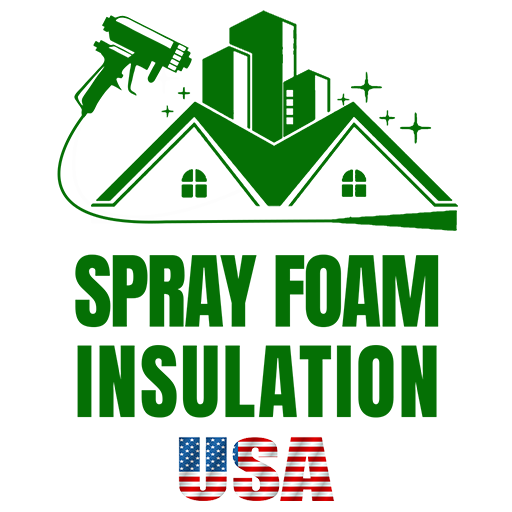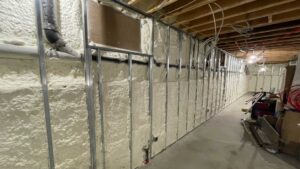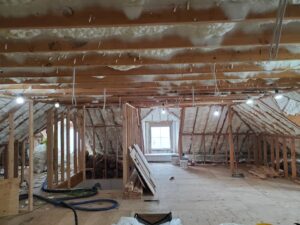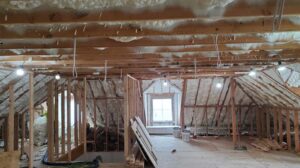Understanding R-Value Insulation: An Essential Guide
When you hear about home or business insulation, “R-Value” is a term that often pops up. But what does it really mean, and why is it so crucial for your New York or New Jersey property? Let’s break it down into simple terms.
R-Value Basics:
– R-Value measures insulation’s resistance to heat flow.
– The higher the R-Value, the better the material insulates.
– Insulation with a higher R-Value can keep your space warmer in the winter and cooler in the summer.
Why does this matter for your home or business? Well, the right insulation can significantly reduce your energy bills, enhance comfort throughout the year, and contribute to a healthier planet by reducing your carbon footprint.
Importance of Insulation:
The insulation in your building acts like a thermal barrier. During cold months, it keeps the warmth in, and in the hot months, it keeps the heat out. Without proper insulation, your heating and cooling systems have to work overtime, draining your wallet and putting unnecessary strain on the environment.
Description: This detailed infographic explains the concept of R-Value in three parts: at the top, a thermometer showing temperature difference between outside and inside; in the middle, a cross-section of a wall with insulation of varying R-Values, illustrating how different materials offer different levels of resistance to heat flow; at the bottom, a simple equation demonstrates how R-Value directly impacts energy efficiency and comfort, emphasizing that higher R-Value equals better insulation. Plus, a bonus tip points out the importance of considering local climate when choosing insulation R-Value, alongside a QR code linking to an R-Value U.S. Map for specific recommendations.
In short, understanding and choosing the right R-Value for your insulation is not just about keeping your home or business comfortable; it’s about making a smart, sustainable investment for the future.
What is R-Value Insulation?
When we talk about keeping our homes warm in the winter and cool in the summer, R-value insulation plays a critical role. But what exactly is it? Let’s break it down into simple terms.
Temperature Difference
Imagine it’s a cold winter day outside, but cozy and warm inside your home. The temperature difference between the outside and inside is what your insulation has to work against. The greater the difference, the harder your insulation has to work to keep your home comfortable.
Heat Flux
Heat flux might sound like a term from a sci-fi movie, but it’s actually a way of describing how heat moves. Heat always wants to move from warmer areas to cooler ones. In your home, this means heat tries to escape during the winter and sneak in during the summer. R-value insulation acts like a superhero, slowing down this movement to keep your home’s temperature just right.
Thermal Resistance
This is where R-value shines. Thermal resistance is a fancy way of saying how good a material is at stopping heat from passing through it. The “R” in R-value stands for resistance. So, a higher R-value means better insulation because it resists heat flow more effectively. It’s like comparing a thin summer jacket to a thick winter coat; the winter coat has a higher “R-value.”
Why It Matters
Choosing the right R-value insulation for your home is crucial. It’s not just about comfort; it’s about efficiency and savings too. Insulation with the proper R-value can significantly reduce your energy bills by keeping your home’s temperature more consistent. Plus, it’s a simple step we can all take to reduce our environmental footprint.
The right R-value for your home depends on where you live. Different climates require different levels of insulation. That’s why it’s important to consult an R-Value U.S. Map to see what’s recommended for your area.
In summary, R-value insulation is all about controlling temperature difference, reducing heat flux, and maximizing thermal resistance. It’s an essential part of making your home more energy-efficient, comfortable, and cost-effective. As we move into the next section, we’ll explore the different types of insulation and their R-values, helping you make the best choice for your home.
Stay tuned as we dive deeper into how to achieve optimal insulation in your home, ensuring comfort and savings year-round.
Types of Insulation and Their R-Values
When it comes to making your home more energy-efficient, understanding the types of insulation and their R-values is key. Let’s break this down into simple terms and look at four main types: Blown-in insulation, Insulation blankets, Spray foam insulation, and Foam board insulation.
Blown-in Insulation
Imagine a big fluffy cloud being gently placed in your attic, filling up all the nooks and crannies. That’s what blown-in insulation is like. It’s made from materials like fiberglass, cellulose, or mineral wool. You can think of it as the “loose change” of insulation because it fills up spaces really well. Its R-value ranges from 2.2 to 4.0 per inch. It’s perfect for attics and hard-to-reach places because it can be blown in through a hose.
Insulation Blankets (Batts and Rolls)
Next up, we have insulation blankets. These come in batts or rolls – like big rolls of cotton candy. They’re usually made from fiberglass or mineral wool. The R-value for these cozy blankets ranges from 3.1 to 3.8 per inch. They’re super easy to install and are best for areas with standard spacing between joists and studs, like walls and floors.
Spray Foam Insulation
Now, let’s talk about the superhero of insulation – spray foam. This stuff is like magic. It expands to fill gaps and cracks, creating an airtight seal. There are two types: open-cell and closed-cell, with closed-cell being the denser and more moisture-resistant of the two. The R-value? A whopping 3.5 to 6.5 per inch! It’s a bit pricier, but it’s worth it for areas that need a tight seal against air and moisture.
Foam Board Insulation
Last but not least, we have foam board insulation. Think of it as a giant, rigid puzzle piece that you can fit in your walls, roof, or floors. It’s made from polystyrene or polyurethane and offers an R-value between 4.0 and 6.5 per inch. It’s great for reducing thermal bridging through wood or metal framing and can be used both inside and outside your home.

Choosing the Right Type for Your Home
Picking the right insulation is like choosing the right winter coat. You need one that fits just right and keeps you warm without being too bulky. Here are some quick tips:
- Attics and hard-to-reach places: Go for blown-in insulation.
- Walls and floors: Insulation blankets are your best bet.
- Gaps and cracks: Nothing beats spray foam insulation.
- Reducing thermal bridging: Foam board insulation is the way to go.
The higher the R-value, the better the insulation at keeping your home cozy and your energy bills low. But also consider your specific needs and budget. Sometimes, a combination of insulation types works best!
Now that you know more about the types of insulation and their R-values, you’re one step closer to making your home more energy-efficient. Next up, we’ll guide you on how to determine the right R-value for your home based on your climate and specific needs.
How to Determine the Right R-Value for Your Home
Choosing the right R-value insulation for your home is like picking the perfect winter coat. You want one that’s just right for the weather. Let’s break down how to make this choice based on where you live and other key factors.
Climate Zones
First things first, your location plays a huge role in determining the R-value you need. The United States is divided into several climate zones, each with its own recommended R-value range for optimal insulation. Living in a colder climate? You’ll need a higher R-value to keep the warmth in. In warmer areas, a lower R-value might be sufficient.
R-Value U.S. Map
Imagine a map that tells you exactly what you need to stay cozy. That’s what the R-Value U.S. Map does. It shows the recommended R-values for different parts of the country. This map is your go-to guide for starting your insulation journey. It simplifies the decision-making process by giving you a clear picture of what’s recommended for your area.
Insulation R-Value Chart
Charts are like treasure maps for information. An Insulation R-Value Chart lists various insulation materials and their corresponding R-values. It’s a handy tool to compare options. For example, if you’re looking at spray foam insulation, this chart can show you the R-values per inch, helping you calculate how much you need for your space.
Local Climate Considerations
Your local climate might have quirks that the broader climate zone descriptions don’t cover. Maybe you live in a valley that gets colder than the surrounding areas, or perhaps your home is exposed to direct sunlight most of the day. These factors can affect how much and what type of insulation you need. It’s always a good idea to consult with local experts who understand these nuances.
Putting It All Together
Now, you’ve got the tools and knowledge to choose the right R-value insulation for your home. It’s about balancing your climate’s demands with the specific needs of your living space. And when in doubt, consulting with a professional can provide personalized advice tailored to your home’s unique characteristics.
By taking the time to understand and apply this information, you’re on your way to a more comfortable, energy-efficient home. Next, we’ll dive into achieving optimal insulation in your home, covering everything from adding layers to insulating those often-forgotten areas. Stay tuned for practical tips to maximize your home’s energy efficiency!
Achieving Optimal Insulation in Your Home
After understanding the importance of R-value insulation, the next step is to ensure your home is wrapped up snugly to fend off the cold or keep the cool in. Let’s talk about how to achieve that cozy, energy-efficient environment by focusing on key areas of your home.
Adding Layers
Think of your home like dressing for winter; layers are your best friend. If certain areas of your home are already insulated but still feel drafty, consider adding an extra layer of insulation. This could mean adding more spray foam insulation on top of existing batts in your attic or walls. It’s like wearing an extra sweater on a chilly day – more layers, more warmth.
Exterior Walls
Your home’s exterior walls are like the outer shell of your armor against the elements. To ensure they’re up to the task, aim for insulation with a high R-value. Spray foam insulation can be particularly effective here because it expands to fill cracks and gaps, ensuring a tight seal. It’s like sealing your home in a protective bubble.
Attics
Heat rises, and if your attic isn’t properly insulated, it’s like leaving the lid off a pot of boiling water. You wouldn’t do that, right? To keep the heat where you want it (inside your home), make sure your attic has a thick layer of high R-value insulation. This could mean using blown-in insulation to get into all the nooks and crannies, ensuring a snug fit.
Crawlspaces
These often-overlooked spaces can be a source of heat loss, especially if they’re not insulated. Think of insulating your crawlspace as putting on a pair of warm socks on a cold floor. It can make all the difference in keeping your home’s feet – the foundation – warm.
Garage
If your garage is attached to your house, insulating it can help maintain your home’s overall temperature. It’s like closing the door to keep the warmth in; you’d be surprised how much heat can escape through an uninsulated garage.
Water Heater and Pipes
Insulating your water heater and pipes is akin to putting a cozy blanket around them. Not only does it keep the heat in, saving energy, but it also prevents your pipes from freezing in the winter. Simple foam pipe insulation can be highly effective and easy to install.
Ceiling
Don’t forget to look up! Insulating your ceiling can help keep the warmth from escaping through the top of your house. It’s like putting a hat on in the winter; it keeps your body heat from disappearing into the air.
Practical Tips:
- Check for Air Leaks: Before adding insulation, ensure there are no air leaks. It’s like checking for holes in your winter coat.
- Consider Professional Help: Some insulation projects, especially spray foam, may require professional installation to ensure the best performance.
- Don’t Forget Ventilation: Proper ventilation is crucial, especially in attics, to prevent moisture buildup. Think of it as allowing your home to breathe while still keeping it warm.
By focusing on these key areas and considering the specific needs of each, you can achieve optimal insulation in your home. Not only will this make your living space more comfortable, but it will also contribute to lower energy bills and a smaller carbon footprint. With the right approach and materials, like those provided by Spray Foam Insulation USA, you’re well on your way to a snug and energy-efficient home.
Remember that every home is unique. Tailoring your insulation strategy to your home’s specific needs is the best way to ensure comfort and efficiency. Stay tuned for answers to frequently asked questions about R-value insulation, where we’ll cover everything from the best R-values for different areas to the benefits of high R-value insulation.
Frequently Asked Questions about R-Value Insulation
When it comes to improving your home’s energy efficiency, understanding R-value insulation is key. Let’s dive into some of the most common questions homeowners have.
What is a good R-value for insulation?
A “good” R-value for insulation depends largely on where you live and the part of your home you’re insulating. As a general rule, colder climates require insulation with higher R-values to maintain a comfortable indoor temperature without overworking your heating system. For example, attics in colder regions might need R-values between R-49 and R-60, while in milder climates, R-30 to R-38 could be sufficient. Always consult the U.S. Department of Energy’s recommendations for your specific area.
Is high R-value better?
In most cases, yes, a [higher R-value means better insulation](https://en.wikipedia.org/wiki/R-value_(insulation). This is because the R-value measures a material’s resistance to heat flow—the higher the R-value, the more resistant it is. However, there is a point of diminishing returns. At a certain point, the cost of achieving higher R-values may not be justified by the amount of energy savings you’ll see. It’s about finding the right balance for your home and climate.
What’s the difference between R13 and R19 insulation?
The main difference between R13 and R19 insulation is their thermal resistance. R13 insulation has a lower R-value, meaning it’s less effective at resisting heat flow compared to R19 insulation. This typically makes R13 suitable for interior walls or milder climates, while R19 is better for exterior walls and colder areas. The choice between them should be based on the specific needs of your home, including the climate you live in and the area of the home you’re insulating.
The right R-value insulation for your home can significantly impact your comfort and energy bills. If you’re looking to upgrade your insulation, consider the unique aspects of your home and consult with professionals to determine the best R-value for your needs. Spray Foam Insulation USA offers a variety of high R-value insulation options that can help you achieve optimal insulation in your home.
Conclusion
When we talk about making our homes more energy-efficient, choosing the right insulation is key. This journey through understanding R-value insulation has shown us that not all insulation is created equal. Different types have different strengths, and what works best for one home might not be the best choice for another. However, one thing remains constant: the higher the R-value, the better the insulation’s ability to resist heat flow.
At Spray Foam Insulation USA, we specialize in providing top-tier insulation solutions that make your home not just a place to live, but a model of energy efficiency. Our spray foam insulation products stand out for their high R-values, offering superior thermal resistance that can keep your home comfortable year-round while helping to reduce your energy bills.
Why does this matter? Because energy efficiency is not just about saving money (though that is a significant benefit). It’s about creating a sustainable future, reducing our carbon footprint, and taking steps toward a healthier planet. By choosing high R-value insulation from Spray Foam Insulation USA, you’re not just investing in your home’s comfort and efficiency. You’re also making a choice that benefits the broader world around us.
We understand that navigating insulation can be complex. That’s why we’re here to help guide you through every step of the process, from understanding the basics of R-value insulation to selecting the right product for your home. Our team of experts is committed to ensuring that your insulation project is a success, providing the support and expertise you need to make informed decisions.
In conclusion, the journey toward a more energy-efficient home starts with understanding and choosing the right insulation. With Spray Foam Insulation USA, you have a partner ready to help you achieve that goal. Our high R-value insulation options are designed to meet the unique needs of your home, offering the energy efficiency, comfort, and sustainability you’re looking for.
Ready to take the next step in your insulation project? Visit our residential insulations page to learn more about how we can help you create a more energy-efficient, comfortable, and sustainable home. Together, we can make a difference, one insulation project at a time.
Thank you for choosing Spray Foam Insulation USA. We look forward to helping you achieve the comfort and efficiency you deserve.





